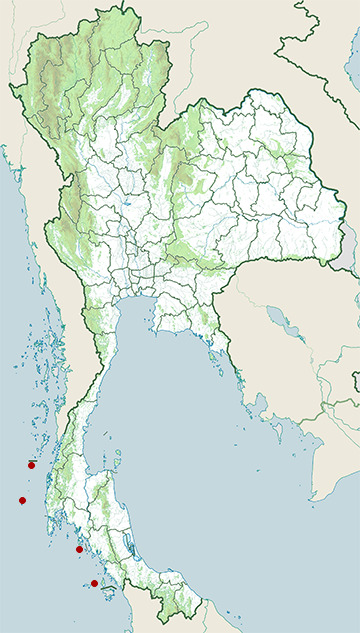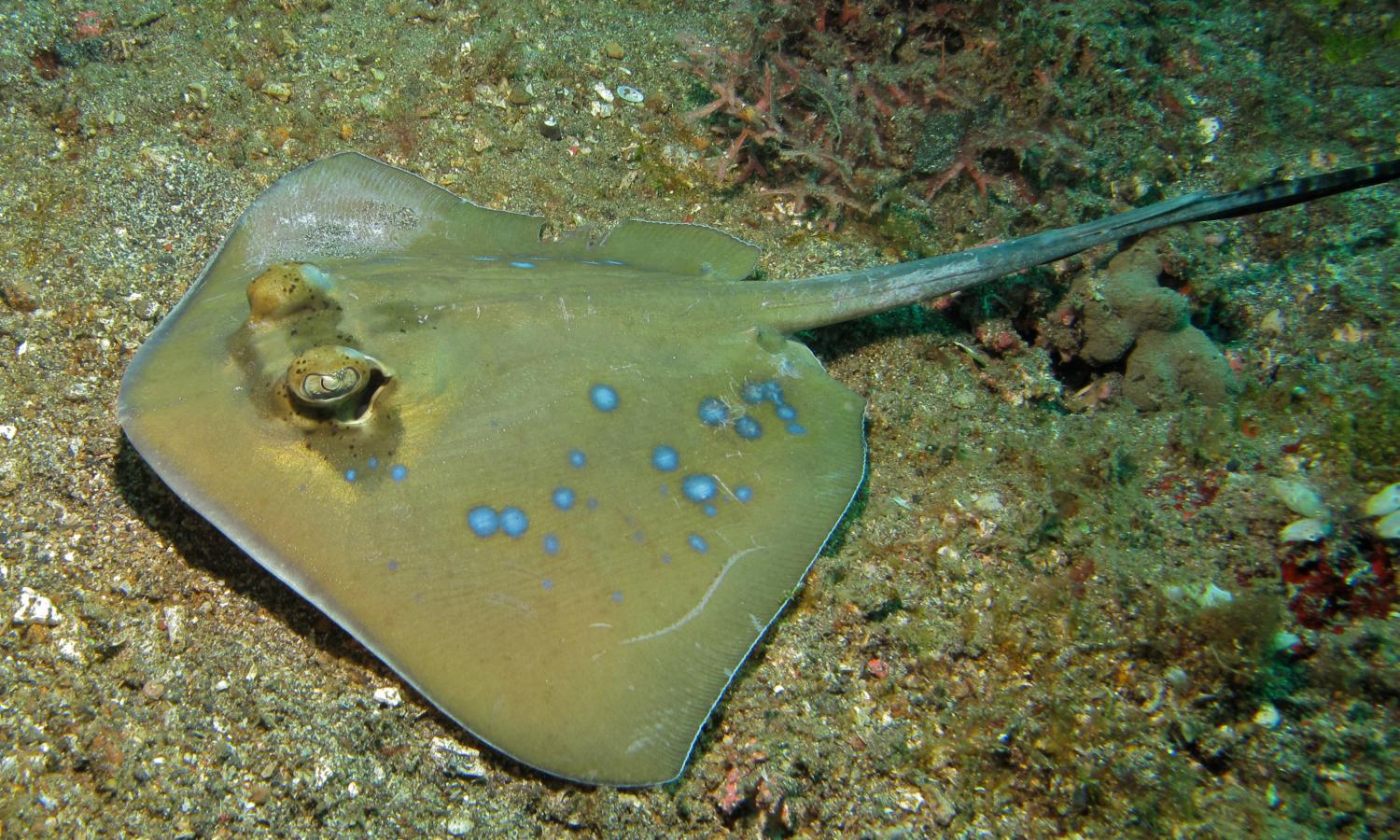Species of Thailand
Kuhl's maskray
Neotrygon kuhlii
Johannes Peter Müller & Friedrich Gustav Jakob Henle, 1841
The bluespotted stingray (Neotrygon kuhlii), also known as the bluespotted maskray or Kuhl's stingray, is a species of stingray of the family Dasyatidae. It was recently changed from Dasyatis kuhlii in 2008 after morphological and molecular analyses show that it is part of a distinct genus, Neotrygon. The body is rhomboidal and colored green with blue spots. Maximum disk width is estimated 46.5 cm sp=us. It is popular in aquaria but usually not distinguished from the bluespotted ribbontail ray. The ribbontail has a rounded body, is a brighter green with brighter blue and more vivid spots, but the bluespotted stingray is larger. The stingray's lifespan is estimated thirteen years of age for females and ten years for males. The bluespotted stingray preys on many fish and small mollusks. The bluespotted stingray is also generally found from Indonesia to Japan, and most of Australia. The bluespotted stingray is also targeted by many parasites such as tapeworms, flatworms, and flukes.
Taxonomy
The bluespotted stingray was discovered by Heinrich Kuhl in Java, Indonesia. The population of this species is greatly debatable due to the five different species of rays in Indonesia. Also, there are two different subgroups: the Java and Bali form. The distinct difference between the two strains is their size, with the Bali being much larger than the Java. On the familial level, the family Dasyatidae is made up of 9 genera and 70 species. The genus of Neotrygon are called maskrays, because of the color pattern around their eyes.
Description and behavior
The bluespotted stingray has a flat disc-like rhomboid body up to 47 cm sp=us in diameter and 70 cm sp=us in total length. Their coloring is a dark green with blue spots with a light white underbelly also known as countershading. Its snout is very short and broadly angular along with its angular disc. The rays' bright coloration serves as a warning for its venomous spines. The ray has a very long tail accommodating two venomous spines on the base of the tail. The tail is about twice as long as the body of the ray, and the barbs or spines are two different sizes, one being very large and the other a medium-sized barb. The bluespotted stingray has bright yellow eyes that are positioned to allow them a wide angle of view. Since the gills are located ventrally, the spiracles allow water to reach the gills while resting or feeding on the benthos. The spiracles are located directly behind the eyes. The mouth is located on the ventral side of the body, which promotes the unique foraging technique of stingrays. Rays are normally solitary individuals but can occur in groups. One unique characteristic of the bluespotted stingray is that they rarely bury themselves in the sand, only to hide from predators, unlike the majority of stingrays who bury themselves regularly to hunt.
Diet
The bluespotted stingray feeds on shrimp, small bony fish, mollusks, crabs and other worms. Due to the fact that this ray is a shallow bottom feeder, it has a small variety of marine life to prey on. The bluespotted stingray overpowers its prey by pinning them to the bottom of the seafloor with its fins. The bluespotted stingray has numerous tiny teeth, with the lower jaw being slightly convex. They also, like most stingrays, have plate-like teeth to crush prey.
Reproduction
The bluespotted stingray is ovoviviparous. The embryos are retained in eggs within the mother's body until they are ready to hatch. The embryos receive nourishment from the mothers' uterine fluid. Mothers give birth to up to seven pups per litter; these pups range from 6 sp=us to 13 sp=us long at birth. The bluespotted stingray passes its offspring 32 sets of chromosomes. The mother also has an annual reproductive cycle. Studies show that the mating season is in October and November and the ovulating season is in the Australian summer (December 1- February 28/29), which coincides with the embryonic development.
Habitat
The bluespotted stingray is commonly found in waters of depths about 0–90 meters (0–295 feet), being commonly found in sand and mudflats, but have also been encountered near rocky coral reefs, and sea grass beds. This stingray is found in a tropical climate at 29°N- 31°S, and 20°E- 171°W. At high tide the bluespotted stingray moves into the shallow lagoons and reef flats. It is found in northern Australia, Kenya, Madagascar, The island of Mauritius, Somalia, the east coast of South Africa, India. The bluespotted stingray is in almost the entire continental waters of Asia, including the Sea of Japan, Yellow Sea, East China Sea, Philippine Sea, Sulu Sea, Java Sea, Banda Sea, Celebes Sea, Andaman Sea, the Bay of Bengal and the Arabian Sea.
Threats and protected areas
In Queensland, Australia there are many areas for high protection of the bluespotted stingray, three being the Shoalwater, Corio Bay's Area Ramsar Site, and the Great Barrier Reef Marine Park. A major threat to the bluespotted stingray is the destruction of coral reefs mainly in the north Western Pacific. The rays dwell in these reefs and the destruction and pollution from fertilizers and pesticides hurt them. The ray is commonly caught in the Java Sea by fishermen trawling and by Danish seine boats in large quantities. The bluespotted stingray is the second most significant species out of the sharks, rays, and skate family to be fished, contributing to about 700 kg sp=us per boat in 2006-2007.
Predators
Larger elasmobranchs, such as hammerhead sharks, prey on the bluespotted stingray. The rays coloration is a warning for the highly venomous barbs, thus few animals attempt to overpower this ray. The hammerhead shark uses its head to pin down the bluespotted stingray, while it is in shock and much weaker.
Human interaction
Due to the unique characteristics of this ray it is very common to be found in pet trade, many people ignore the fact that in total maturity the size of the ray exceeds the capacity of many household aquariums. The bluespotted stingray is generally fished for its meat, being either smoked and salted or dried for local markets, but inexpensive due to its small size. It is caught in mass in bottom trawl, trammel, and fish traps. The bluespotted stingray is very venomous and it has a barb approximately 12 sp=us long. The venom contains serotonin, 5' nucleotidase, and phosphodiesterase.
The skin of the bluespotted stingray is often used for drums such as on the Arab and Turkish darbuka goblet drum and riq (def) tambourine.
Parasites
There are many parasites that inhibit the bluespotted stingray, this is a table of the common groups of the parasite, and the specific name of the parasite.
| Common Class | Group | Parasite |
|---|---|---|
| Tapeworms | Cestodes cephalobothriidae | | Cephalobothrium longisegmentum and Tylocephalum kuhli |
| Tapeworms | Cestodes mixodigmatidae | | Trygonicola macroporus |
| Tapeworms | Cestodes onchobothriidae | | Acanthobothrium bengalens, Acanthobothrium confusum, Acanthobothrium herdmani, and Acanthobothrium pingtanensis |
| Tapeworms | Cestodes phyllobothriidae | | Echeneibothrium trygonis, Phyllobothrium ptychocephalum, Rhinebothrium shipleyi, Scalithrium shipleyi, and Scalithrium trygonis |
| Flatworms | Monogeneans monocotylidae | | Dendromonocotyle kuhlii, Heterocotyle chinensis, Monocotyle kuhlii, and Monocotyle tritestis |
| Flukes | Trematodes monocotylidae | | Prosorhynchus clavatum |
| Flukes | Trematodes didymozoidae | | Didymozoid larva |
This article uses material from Wikipedia released under the Creative Commons Attribution-Share-Alike Licence 3.0. Eventual photos shown in this page may or may not be from Wikipedia, please see the license details for photos in photo by-lines.
Scientific classification
- Kingdom
- Animalia
- Phylum
- Chordata
- Class
- Chondrichthyes
- Order
- Myliobatiformes
- Family
- Dasyatidae
- Genus
- Neotrygon
- Species
- Neotrygon kuhlii
Common names
- English: Bluespotted stingray
Synonyms
- Trygon kuhlii, Johannes Peter Müller & Friedrich Gustav Jakob Henle (1841)
- Dasyatis kuhlii, Johannes Peter Müller & Friedrich Gustav Jakob Henle (1841)
Conservation status
Data Deficient (IUCN3.1)
Photos
Please help us review our species pages if wrong photos are used or any other details in the page is wrong. We can be reached via our contact us page.
Range Map

- Ko Lanta National Park
- Similan Islands
- Surin Islands
- Tarutao National Marine Park

